ASM Summer Student Research Awards: 2019
Microbiology Australia 40(3) 147-150 https://doi.org/10.1071/MA19041
Published: 16 September 2019
Priscilla Johanesen
ASM Student and Early Career Microbiologist Engagement Coordinator

|
This year the society awarded nine ASM Summer Student Research Awards. These awards are run as a collaboration between national office and state branches and are a fantastic opportunity for students to complete a research project in a laboratory over the summer vacation period. This activity allows students to gain valuable experience in a microbiology research laboratory. This year the successful awardees were: Joshua Dubowsky from South Australia; Amy Griffith and Mikaela G Bell from Queensland; Cassandra Stanton, Joshua J Vido and Yinglei Hua from Victoria; and Wenna Lee, Andrew Vaitekenas, and Alicia Tan Yi Jia from Western Australia. As you will see from the student’s abstracts, awardees performed research on wide-ranging areas of microbiology from microbial communities in a tropical rainforest ecosystem through to human and veterinary microbial pathogens. The society congratulates all of the winners of the 2019 awards.
South Australia
Investigating transcriptional disparity in components of the complement alternative pathway between different cell types infected with dengue virus

|
Joshua Dubowsky
Supervised by: Associate Professor Jill Carr
Microbiology and Infectious Diseases, College of Medicine and Public Health, Flinders University, Adelaide, SA, Australia
Dengue virus (DENV) is the most significant arbovirus affecting human health worldwide yet there is currently no approved treatment to combat the disease it causes. The severe symptoms that can result from DENV infection have clinical features similar to those caused by complement alternative pathway (AP) overactivity and our laboratory has previously shown that DENV infection induces complement factor H (FH) mRNA. This mRNA could encode for full length FH, or a shorter FH‐like protein (FHL‐1), which has different properties in regulating the AP. The aim of this project was to quantify the levels of these two alternative transcripts, in DENV infected cells. DENV infection in both HeLa and MDM significantly increased mRNA transcripts from the 5’ end of FH however, significant increases in further 3’ and full‐length FH transcripts were only observed in DENV‐MDM. Furthermore, DENV‐MDM but not HeLa demonstrated a significant increase in FHL‐1 mRNA. MDM represent the natural in vivo target for DENV infection and demonstrates that the full transcriptional response of FH to DENV‐infection is not mimicked by routine laboratory cell lines such as HeLa. However, HeLa remain suitable for investigating mechanisms of the FH mRNA induction at the level of the promoter. Establishing this methodology will benefit further characterisation of DENV induction of FH and FHL‐1 mRNA in other target cells for DENV replication, such as endothelial cells.
Queensland
Characterising outer membrane vesicles (OMVs) of Moraxella catarrhalis
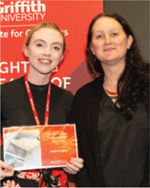
|
Amy Griffith
Supervised by: Dr Aimee Tan and Associate Professor Kate Seib
Institute for Glycomics, Griffith University, Qld, Australia
Moraxella catarrhalis is an important human restricted pathogen associated with otitis media in children and chronic obstructive pulmonary disease (COPD) exacerbations in adults. Outer membrane vesicles (OMVs) are naturally produced from the outer membrane of Gram-negative organisms including M. catarrhalis and have roles in virulence. This study characterised genes involved in OMV biogenesis, protein composition of OMVs and the effects of OMV formation on virulence mechanisms including biofilm formation and serum survival. We identified one gene involved in OMV formation, with ~2–4-fold increase in OMV production in the M. catarrhalis 195ME and 25239 mutant strains lacking this gene. This study also characterised OMV composition of the wild-type M. catarrhalis 195ME and 25239 strains, identifying strain dependent differences in composition. In addition, data from phenotypic assays suggested that serum survival is altered by OMV concentration; M. catarrhalis 25239 has decreased serum survival when cells are washed prior to the assay representing a hypovesiculating phenotype and have increased serum survival when exogenous OMVs are added. This information helps to understand OMV biogenesis and pathogenesis of M. catarrhalis, while also aiding in the characterisation of M. catarrhalis OMV protein composition.
Development of a novel Stenotrophomonas maltophilia real-time PCR assay
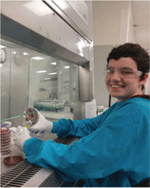
|
Mikaela G BellA,B
Supervisors and co-authors: Dr Tamieka A FraserA,B, Dr Patrick HarrisC,D, Professor Scott C BellE, Mr Haakon BerghC, Professor Graeme NimmoC, Dr Derek S SarovichA,B and Dr Erin P PriceA,B
ASunshine Coast Health Institute, Birtinya, Qld, Australia; BGeneCology Research Centre, University of the Sunshine Coast, Sippy Downs, Qld, Australia; CMicrobiology Department, Central Laboratory, Pathology Queensland, Herston, Qld, Australia; DUniversity of Queensland Centre for Clinical Research, Herston, Qld, Australia; EQIMR Berghofer Medical Research Institute, Herston, Qld, Australia
Stenotrophomonas maltophilia is a Gram-negative, multi-drug-resistant environmental bacterium that is emerging as an important respiratory pathogen in those afflicted with the multiorgan disease, cystic fibrosis (CF). S. maltophilia is also recognised as a threatening nosocomial pathogen, especially among the paediatric population, and its presence in those afflicted with CF is associated with more advanced diseases. With a history of being overlooked as a pathogen in its own right, it is currently unclear how widespread S. maltophilia is amongst CF cases, so its role in disease pathogenesis remains enigmatic. Currently, there are no rapid, highly-accurate methods for the detection of S. maltophilia, meaning that its true prevalence is likely being underestimated. The goal for this study was to use large-scale comparative genomics of S. maltophilia and near-neighbour species to identify a highly-specific genetic target for this emerging pathogen, and to subsequently develop and test a newly designed PCR assay for its specific detection. The assay designed was successfully able to detect all 89 clinical S. maltophilia samples with 100% accuracy. Future work will entail screening of non-S. maltophilia strains, and determine the limits of detection and quantitation for this new assay.
Victoria
The genetic manipulation of bacteriophage, CSP3, for the detection of Burkholderia cepacia
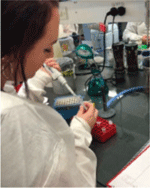
|
Cassandra Stanton
Supervisors: Dr Steven Batinovic and Dr Steve Petrovski
Department of Physiology, Anatomy and Microbiology, La Trobe University, Bundoora, Vic., Australia
A phage infective for two clinical strains of B. cepacia, CSP3, was previously isolated and characterised. In this study, CSP3 was used for the development of a biosensor through the addition of a fluorophore (GFP) onto the N-terminus of Orf25, the predicted major capsid protein. Two homology arms were PCR amplified from the CSP3 genome and cloned in either side of gfp with no stop codon to create the vector pBBR1-NW. pBBR1-NW was then conjugated into B. cepacia and grown with wildtype CSP3. It was hypothesised that as CSP3 infected B. cepacia containing pBBR1-NW, the regions of homology between the phage and vector would undergo a double cross-over homologous recombination event, with gfp being inserted into CSP3. GFP would form a fusion protein at the N-terminus of Orf25, resulting in translation and expression of GFP during phage replication. Plaques were screened by PCR assays to detect recombinant phages. This study presents a method for producing phage biosensors able to detect B. cepacia or to be further applied to other phages and pathogenic bacteria for their sensitive detection.
Exploring the influence of soil abiotic components on microbial community structure within a tropical rainforest ecosystem
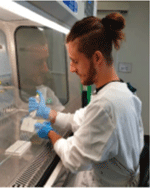
|
Joshua J Vido
Supervisors: Dr Jennifer Wood and Associate Professor Ashley Franks
Department of Physiology, Anatomy and Microbiology, La Trobe University, Bundoora, Vic., Australia
Tropical rainforests harbour the greatest amount of plant diversity of all naturally occurring ecosystems on earth. However, the rapidly changing climate is placing a significant threat on the biodiversity within these ecosystems. Observations into the microbial community dynamics within soil may provide an understanding of how tropical rainforests may be altered from climate change. This is due to microbial communities responding rapidly to environmental change, while the response may be delayed in above-ground organisms such as mature plants. This study aimed to analyse abiotic factors (moisture, pH and electrical conductivity) of soil samples collected from a tropical rainforest in far North Queensland, Australia, in order to investigate the relationship between these factors as well as their influence on bacterial, fungal and oomycete communities. The elevation within the study site where each soil sample was taken was observed to influence microbial community structure, resulting in high beta diversity along the elevation gradient, it was proposed that pH was a major contributor as a strong negative correlation between pH and elevation was observed. This provides an understanding of the soil dynamics underpinning microbial community structure which can be furthered explored through more comprehensive analysis techniques such as next-generation sequencing.
Investigation of pneumococcal gene expression associated with pneumonia pathogenesis

|
Yinglei HuaA,B
Supervisors: Dr Eileen DunneA,C and Associate Professor Catherine SatzkeA,B,C
AMurdoch Children’s Research Institute, Royal Children’s Hospital, Parkville, Vic., Australia; BDepartment of Microbiology and Immunology at the Peter Doherty Institute for Infection and Immunity, The University of Melbourne, Parkville, Vic., Australia; CDepartment of Paediatrics, The University of Melbourne, Parkville, Vic., Australia
Streptococcus pneumoniae (the pneumococcus) is the most common cause of community acquired pneumonia. However, it is also commonly found as an asymptomatic coloniser of the upper respiratory tract. It is not clear how this pathogen may change from the colonisation state to causing disease. This project investigated pneumococcal gene expression in the nasopharynx and the lung using a unique collection of paired nasopharyngeal swab and lung aspirate samples. It aimed to elucidate the molecular processes by which the pneumococcus can transition from the carriage to infection state, and identify potential genes involved in pathogenesis of pneumococcal pneumonia. RNA was extracted directly from clinical samples and transcriptomic changes were examined by reverse transcription quantitative PCR (RT-qPCR). Previously, expression of pneumococcal virulence genes has been examined using RNA from five pairs of culture-positive nasopharyngeal swabs and lung aspirates. For the remaining culture-negative clinical samples, sufficient pneumococcal RNA was obtained from nasopharyngeal swabs, but not from culture-negative lung aspirates, for RT-qPCR analysis. In the future, gene expression in the nasopharyngeal swabs from pneumonia patients will be compared with the swabs collected from healthy controls, to investigate whether the pneumococcus changes its behaviour dramatically in the nasopharynx of pneumonia patients compared with healthy controls.
Western Australia
Molecular characterisation of canine haemotropic Mycoplasma in Australia

|
Wenna Lee
Supervisors: Dr Charlotte Oskam, Dr Amanda Barbosa and Professor Peter Irwin
Murdoch University, WA, Australia
Emerging infectious diseases (EIDs) are a serious threat to public health and a quarter of EIDs are zoonotic, directly caused by arthropod vectors. However, efforts to control outbreaks of EIDs are sometimes limited by a lack of information, such as identification of aetiological agents, genetic diversity and transmission dynamics. Ticks are important arthropod vectors that transmit causative agents associated with tick-borne diseases (TBDs), such as Babesia, Anaplasma and Mycoplasma spp. This study aimed to molecularly characterise haemotropic Mycoplasma spp. in a group of dogs (blood samples n =10) and haematophagous ticks (Rhipicephalus sanguineus; n = 20). While all ticks tested were negative for Mycoplasma, six out of 10 (60%) dogs screened were positive. Sanger sequencing revealed two dogs were infected with Mycoplasma haemocanis and four dogs were infected with Mycoplasma haematoparvum; both species were genetically identical (100%) to GenBank references. While R. sanguineus is a known vector for mycoplasmas overseas, the R. sanguineus analysed in this study were all negative. However, this is the first study to report 60% prevalence of mycoplasmas in dogs from an anonymous kennel. Further research should focus on determining if the prevalence observed in this study is representative of other kennel dwelling dogs across Australia.
Bacteriophage to treat Pseudomonas aeruginosa infection in cystic fibrosis’ patient lungs
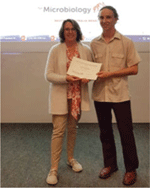
|
Andrew Vaitekenas
Supervisors: Associate Professor Anthony Kicic and Dr Stephanie Trend
Telethon Kids Institute, WA, Australia
Cystic fibrosis is characterised by recurrent bacterial infections principally with Pseudomonas aeruginosa. Treatment of infections is currently possible, but antibiotic-resistant bacteria, of which P. aeruginosa is a high priority, threaten to make this impossible. Bacteriophages are candidates for the treatment of antibiotic-resistant infections. Propagation is one of the first steps in preparing bacteriophages for therapeutic purposes and screening. Commercial and academic sources of P. aeruginosa bacteriophages and propagation conditions were identified for later use. A stock of bacteriophage E79 had a titre of 7.2 × 106, ~2 logs less than when it was prepared in 2016, indicating that it was relatively stable at 4°C over time. High multiplicity of infections (the ratio of bacteriophage to bacteria; MOI) was tested in a pilot experiment, which suggested that smaller MOIs (e.g. 0.001) were optimum and that initially high bacteriophage density impeded production of progeny. Changes to the protocol that included MOIs from 0.1–0.001 and infection of log-phase bacteria, did not have a marked effect on E79 titre but could be implemented to decrease the time propagation takes.
Using bioinformatics to identify novel virulence factors responsible for the persistence and threat of penicillin-resistant serogroup W Neisseria meningitidis in Western Australia

|
Alicia Tan Yi Jia
Supervisors: Dr Shakeel Mowlaboccus and Associate Professor Charlene Kahler
School of Biomedical Sciences, The University of Western Australia, WA, Australia
Neisseria meningitidis causes invasive meningococcal disease (IMD), which presents as septicaemia and/or meningitis. During asymptomatic carriage of N. meningitidis in the nasopharynx, acquisition of DNA via homologous recombination from closely related bacteria is frequent, resulting in a highly dynamic population structure. In Western Australia, IMD is predominantly caused by MenW:cc11 meningococci that belongs to two phylogenetically distinct clusters, A and B, which contain penicillin-susceptible and penicillin-resistant isolates, respectively. Interestingly, Cluster B has expanded more rapidly than Cluster A. In this comparative genomics project, we identified horizontal gene transfer events responsible for the emergence and evolution of the penicillin-resistant meningococci. Potential novel virulence factors were described and the prevalence of novel virulence factors in other genetic lineages of N. meningitidis was also studied. Various virulence factors such as genes involved in metabolism, iron uptake and transport, amino acid biosynthesis, lipooligosaccharide assembly and modification were identified. Homology to proteins in commensals and pathogens colonising the nasopharynx was observed, with possible acquisition of virulence factors via homologous recombination. Possible factors responsible for the global increase in reduced penicillin susceptibility have also been defined. These factors should be studied in mutagenic assays and targeted to address the fitness and persistence of penicillin-resistant meningococci.


